1994 PONTIAC GRAND-AM service
[x] Cancel search: servicePage 134 of 274

At the entrance there is usually a ramp
that leads to the freeway. If you have a
clear view of the freeway as you drive
along
the entrance ramp, you should
begin to check traffic. Try to determine
where you expect
to blend with the flow.
Try to merge into the gap at close
to the
prevailing speed. Switch on your turn signal, check your mirrors and glance
over your shoulder as often as necessary.
Try to blend smoothly with the traffic
flow.
Once you are on the freeway, adjust your
speed to the posted limit or to the
prevailing rate if it’s slower. Stay in the
right lane unless you want to pass.
Before changing lanes, check your
mirrors. Then use your turn signal.
Just before you leave the lane, glance
quickly over your shoulder to make sure
there isn’t another vehicle in your “blind”
spot.
Once you are moving on the freeway,
make certain you allow a reasonable following distance. Expect to move
slightly slower at night.
When you want to leave the freeway,
move to the proper lane well
in advance.
If you-miss your exit do not; under any
circumstances, stop and back
up. Drive on
to the next exit.
The exit ramp can be curved, sometimes
quite sharply.
The exit speed is usually posted.
Reduce your speed according to your
speedometer, not to your sense of motion.
After driving for any distance at higher
speeds, you may tend to think you are
going slower than you actually are.
Before Leaving on a
Long Trip
Make sure you’re ready. Try to be well
rested. If
you must start when you’re not
fresh
-- such as after a day’s work --
don’t plan to make too many miles that
first part of the journey. Wear comfortable
clothing and shoes you can easily drive
in.
Is your vehicle ready for a long trip? If
you keep it serviced and maintained, it’s
ready to go. If it needs service, have it
done before starting out. .Of course, you’ll
find experienced and able service experts
in Pontiac dealerships all across North
America. They’ll be ready and willing to
help if you need it.
Here are some things you can check
before a trip:
0
0
0
0
0
0
0
Windshield Washer Fluid: Is the
reservoir full? Are all windows clean
inside and outside?
Wiper Blades: Are they in good
shape?
Fuel, Engine Oil. Other Fluids: Have
you checked all levels?
Lights:’
Are they all working? Are the
lenses clean?
Tires: They are vitally important to a
safe, trouble-free trip. Is the tread
good enough for long-distance
driving?
Are the tires all inflated to
the recommended pressure?
Weather Forecasts: What’s the
weather outlook along your route?
Should you delay your trip a short
time to avoid a major storm system?
Maps: Do you have up-to-date maps?
133...
ProCarManuals.com
Page 135 of 274

Your Driving and the Road
Highway Hypnosis
Is there actually such a condition as
“highway hypnosis”? Or is it just plain
falling asleep at the wheel? Call it
highway hypnosis, lack of awareness, or
whatever.’
There is something about an easy stretch
of road with the same scenery, along with
the hum of the tires on the road, the drone
of the engine, and the rush of the wind
against the vehicle that can make you
sleepy. Don’t let it happen to you! If it
does, your vehicle can leave the road in
less than a second, and you could crash
and
be injured.
What can you do about highway
hypnosis? First, be aware that it can
happen.
Second, here are some tips:
Make sure your vehicle is well
ventilated, with a comfortably cool
interior.
Keep your eyes moving. Scan the road
ahead and to the sides. Check your
rearview mirrors and your instruments
frequently.
If you get sleepy, pull off the road into
a rest, service, or parking area and
take a nap, get some exercise, or both.
For safety, treat drowsiness on the
highway as an emergency.
Hill and Mountain
Roads
Driving on steep hills or mountains is
different from driving in flat or rolling
terrain.
If you drive regularly in steep country, or
if you’re planning
to visit there, here are
some tips that can make your trips safer
and more enjoyable.
0 Keep your vehicle in good shape. Check all fluid levels and also the
brakes, tires, cooling system and
transaxle. These parts can work hard
on mountain roads.
ProCarManuals.com
Page 143 of 274
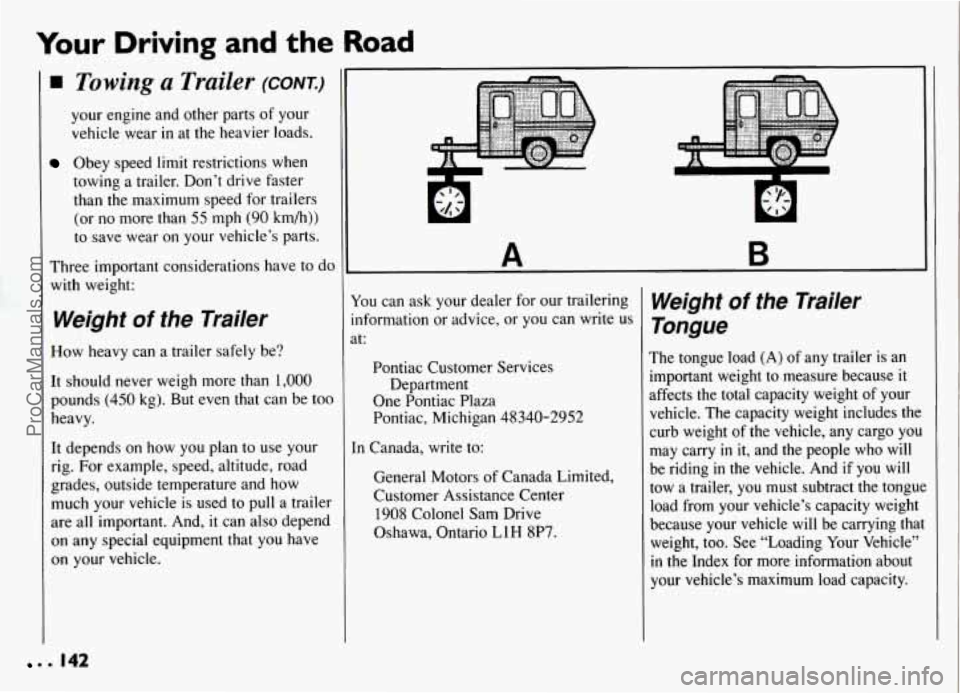
Your Driving and the Road
Towing a Trailer (CONK)
your engine and other parts of your
vehicle wear
in at the heavier loads.
Obey speed limit restrictions when
towing a trailer. Don’t drive faster
than the maximum speed for trailers
(or no more than
55 mph (90 km/h))
to save wear on your vehicle’s parts.
Three important considerations have to do
with weight:
Weight of the Trailer
How heavy can a trailer safely be?
It should never weigh more than 1,000
pounds (450 kg). But even that can be too
heavy.
It depends on how you plan to use your
rig. For example, speed, altitude, road
grades, outside temperature and how
much your vehicle is used to pull a trailer
are all important. And,
it can also depend
on any special equipment that you have
on your vehicle.
A B
fou can ask your dealer for our trailering
nformation or advice, or you can write
us
It:
Pontiac Customer Services
Department
One Pontiac Plaza
Pontiac, Michigan 48340-2952
[n Canada, write to:
General Motors of Canada Limited,
Customer Assistance Center
1908 Colonel Sam Drive
Oshawa, Ontario L1H 8P7.
Weight of the Trailer
Tongue
The tongue load (A) of any trailer is an
important weight to measure because
it
affects the total capacity weight of your
vehicle. The capacity weight includes the
curb weight of the vehicle, any cargo you
may carry
in it, and the people who will
be riding in the vehicle. And if you will
tow a trailer, you must subtract the tongu
load from your vehicle’s capacity weight
because your vehicle
will be carrying tha
weight, too. See “Loading Your Vehicle”
in the Index for more information about
your vehicle’s maximum load capacity.
. . 142
ProCarManuals.com
Page 147 of 274
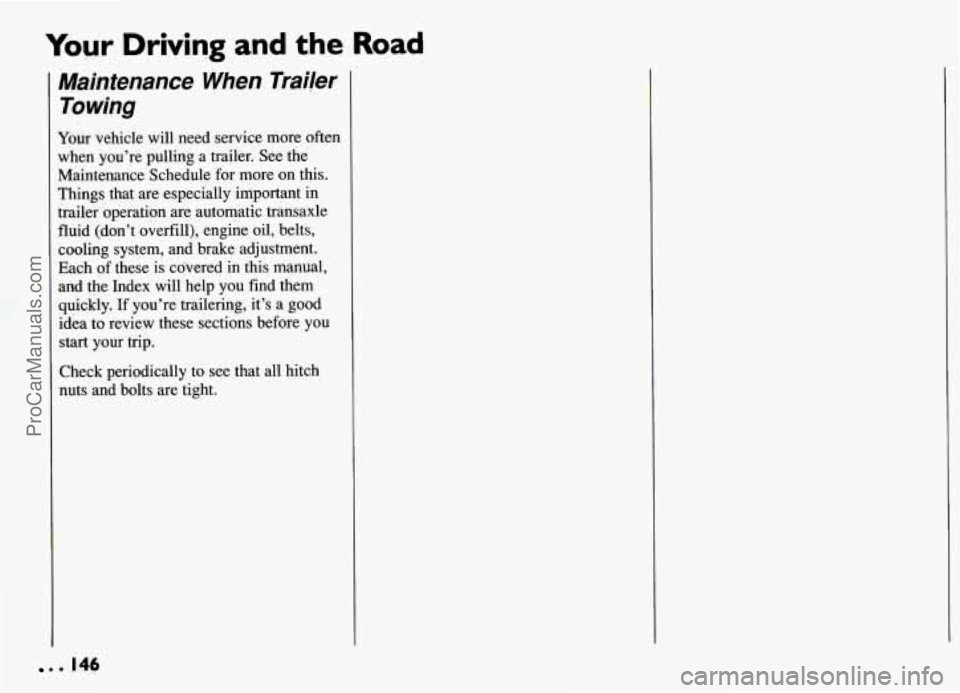
Your Driving and the Road
Maintenance When Trailer
Towing
Your vehicle will need service more often
when you’re pulling a trailer. See the
Maintenance Schedule for more on this.
Things that are especially important in
trailer operation are automatic transaxle
fluid (don’t overfill), engine oil, belts,
cooling system, and brake adjustment.
Each of these is co%ered in this manual,
and the Index will help you find them
quickly. If you’re trailering, it’s a good
idea to review these sections before
you
start your .trip.
Check periodically to see that all hitch
b e 146
ProCarManuals.com
Page 153 of 274
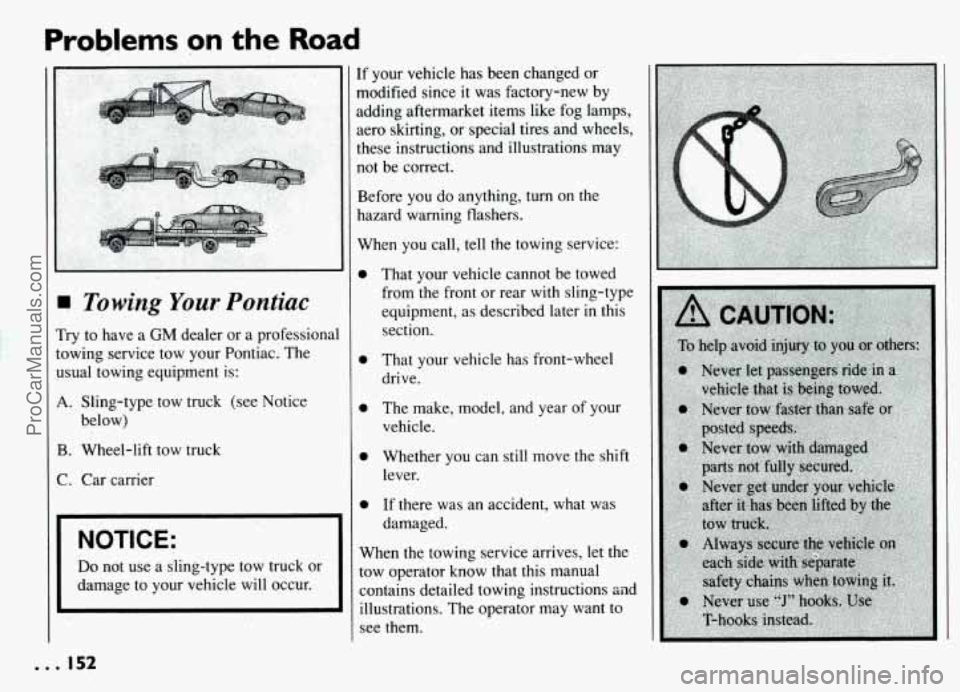
Problems .' on the .Road
3 Towing Your Pontiac
'ry to have a GM dealer or a professional
)wing service tow your Pontiac. The
sua1 towing equipment is:
L Sling-type tow truck (see Notice
below)
!. Wheel-lift tow truck
:. Car carrier
NOTICE:
Do not use a sling-type tow truck or
damage to your vehicle will occur.
If your vehicle has been changed or
modified since it was factory-new by
adding aftermarket items like fog lamps,
aero skirting, or special tires and wheels,
these instructions and illustrations may
not be correct.
Before you do anything, turn on the
hazard warning flashers.
When you call, tell the towing service:
0 That your vehicle cannot be towed
from the front or rear with sling-type
equipment, as described later in this
section.
0 That your vehicle has front-wheel
drive.
0 The make, model, and year of your
vehicle.
0 Whether you can still move the shift
lever.
0 If there was an accident, what was
damaged.
When the towing service arrives, let the
tow operator know that this manual
contains detailed towing instructions sad
illustrations: The operator may want to
see them.
ProCarManuals.com
Page 154 of 274
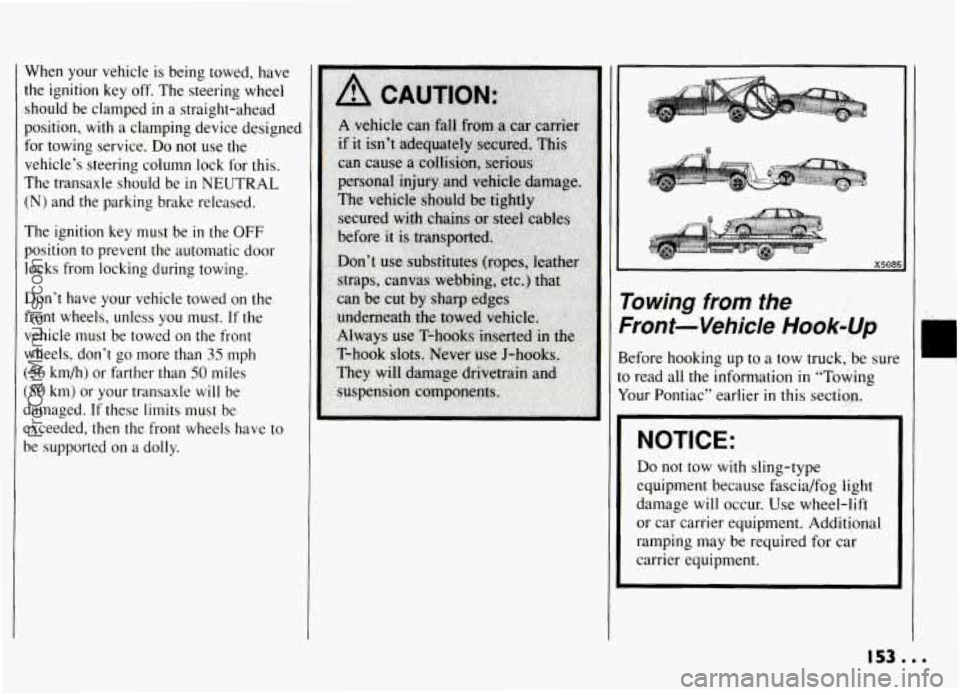
When your vehicle is being towed, have
the ignition key off. The steering wheel
should be clamped
in a straight-ahead
position,
with a clamping device designed
for towing service.
Do not use the
vehicle’s steering column lock for this.
The transaxle should be
in NEUTRAL
(N) and the parking brake released.
The ignition key must be in the OFF
position to prevent the automatic door
locks from locking during towing.
Don’t have your vehicle towed on the
front wheels, unless you must. If the
vehicle must be towed on the front
wheels, don’t go more than
35 mph
‘56 i. km/h) or farther than 50 miles
:SO km) or your transaxle will be
ilamaged. If these limits must be
:xceeded, then the front wheels have to
,e supported on a dolly.
,I 7
F
B
tc
Y
I
1
‘owing from the
?ont-Vehicle Hook-Up
efore hooking up to a tow truck, be sur(
1 read all the information in “Towing
our Pontiac” earlier
in this section.
NOTICE:
Do not tow with sling-type
equipment because fascia/fog light
damage will occur. Use wheel-lift
or car carrier equipment. Additional
ramping may be required for car
carrier equipment.
153...
ProCarManuals.com
Page 158 of 274
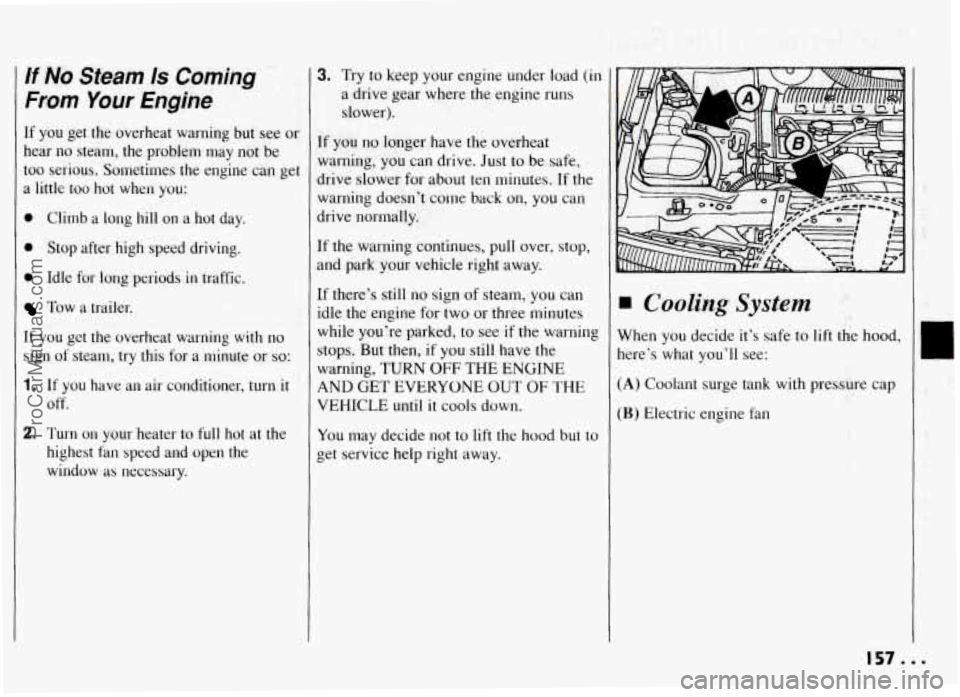
If No Steam 1s Coming
From Your Engine
If you get the overheat warning but see or
hear no steam, the problem may not be
too serious. Sometimes the engine can get
a little too hot when you:
0 Climb a long hill on a hot day.
0 Stop after high speed driving.
0 Idle for long periods in traffic.
Tow a trailer.
[f you get the overheat warning with no
sign of steam, try this for a minute or so:
1. If you have an air conditioner, turn it
off.
2. Turn on your heater to full hot at the
highest fan speed and open the
window as necessary.
3. Try to keep your engine under load (in
a drive gear where the engine runs
slower).
If you no longer have the overheat
warning,
you can drive. Just to be safe,
drive slower for about ten minutes.
If the
warning doesn't come back on, you can
drive normally.
If the warning continues, pull over, stop,
and park your vehicle right away.
[f there's still no sign of steam, you can
idle the engine for two or three minutes
while you're parked, to see
if the warning
stops. But then, if you still have the
warning, TURN
OFF THE ENGINE
4ND GET EVERYONE OUT
OF THE
VEHICLE until it cools down.
You may decide not to lift the hood but to
get service help right away.
Cooling System
When you decide it's safe to lift the hood,
here's what you'll see:
(A) Coolant surge tank with pressure cap
(B) Electric engine fan ii" , I .. i I. i. 4:. .;I'
.r': 5.
157...
ProCarManuals.com
Page 159 of 274
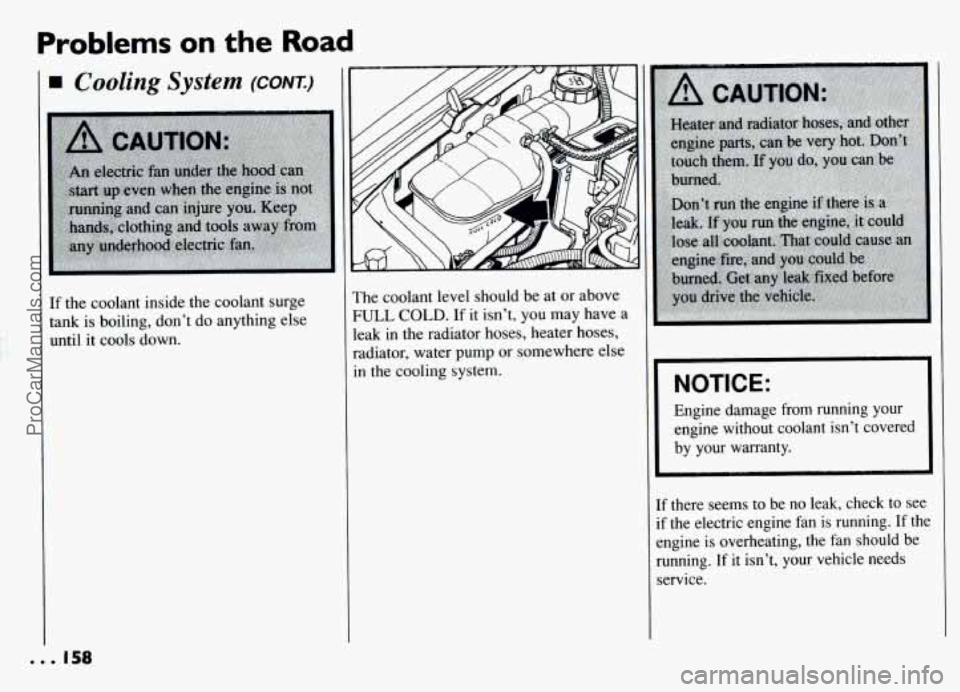
Problems on the Road
1 Cooling System (CONK)
If the coolant inside the coolant surge
tank is boiling, don’t do anything else
until it cools down. The coolant level should be at or above
FULL COLD. If it isn’t, you may have a
leak in the radiator hoses, heater hoses,
radiator, water pump or somewhere else
in the cooling system. ~~~
NOTICE:
Engine
damage from running your
engine without coolant isn’t covered
by your warranty.
If there seems to be no leak, check to see
if the electric engine fan is running. If the
engine is overheating, the fan should be
running. If it isn’t, your vehicle needs
service.
e e e 158
ProCarManuals.com